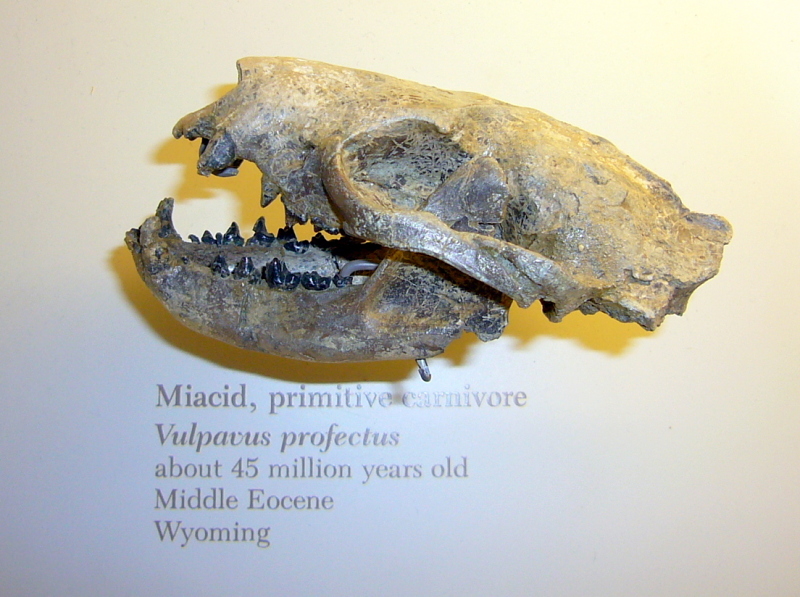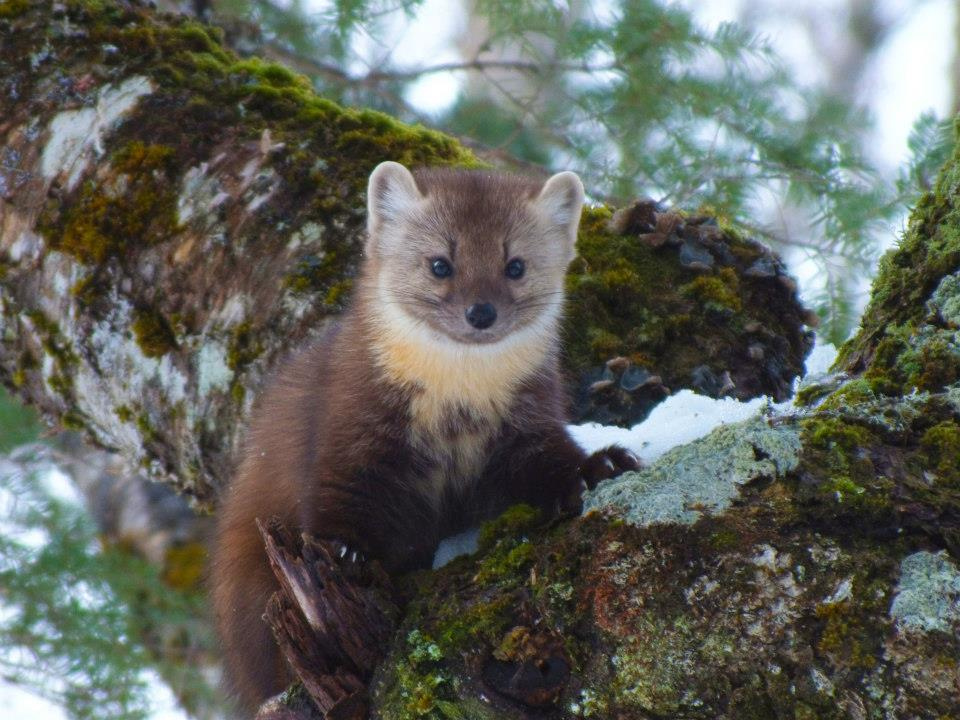|
Miacinae
Miacids are extinct primitive carnivoramorphans within the family Miacidae that lived during the Paleocene and Eocene epochs, about 62–34 million years ago. Miacids existed for approximately . Miacids are thought to have evolved into the modern carnivorous mammals of the order Carnivora. They were small carnivores, superficially marten-like or civet-like with long, lithe bodies and long tails. Some species were arboreal, while others lived on the ground. They probably fed on invertebrates, lizards, birds, and smaller mammals like shrews and opossums. Their teeth and skulls show that the miacids were less developed than modern carnivorans. They had carnivoran-type carnassials, but lacked fully ossified auditory bullae (rounded protrusions). Classification Miacidae as traditionally conceived is not a monophyletic group; it is a paraphyletic array of stem taxa. Traditionally, Miacidae and Viverravidae had been classified in a superfamily, Miacoidea. Today, Carnivor ... [...More Info...] [...Related Items...] OR: [Wikipedia] [Google] [Baidu] |
Paroodectes
''Paroodectes'' is a miacid animal that lived during the early Eocene (ca. 50 million years ago) in the rain forests and swamps of the present-day Germany. It was a prehistoric predator that had the size and the appearance of a cat and was well adapted to climbing, as is apparent from its limbs, joints and shoulder bones. Its long tail gave balance for tree climbing and jumping from branch to branch. ''Paroodectes'' probably hunted insects, rodents and small primates in the tree tops. Only one species of ''Paroodectes'' (''P. feisti'') has been found, and this was at the Messel Pit located southeast of Frankfurt, Germany. The pit was formed during the Geiseltalian Period (or Middle Eocene) about 50 million years ago. The fossil was found by private collector Otto Feist in 1974. It was described in 1980 by Rainer Springhorn who said the following about the species: "The odontological features of the Messel-Miacid are nearest to the new world genus Oodectes from the Bridger Basin ( ... [...More Info...] [...Related Items...] OR: [Wikipedia] [Google] [Baidu] |
Early Paleocene
The Danian is the oldest age or lowest stage of the Paleocene Epoch or Series, of the Paleogene Period or System, and of the Cenozoic Era or Erathem. The beginning of the Danian (and the end of the preceding Maastrichtian) is at the Cretaceous–Paleogene extinction event . The age ended , being followed by the Selandian. Stratigraphic definitions The Danian was introduced in scientific literature by German-Swiss geologist Pierre Jean Édouard Desor in 1847 following a study of fossils found in France and Denmark.Danien He identified this stage in deposits from [...More Info...] [...Related Items...] OR: [Wikipedia] [Google] [Baidu] |
Vassacyon
''Vassacyon'' is an extinct genus of Miacidae. It contains two species; ''Vassacyon promicrodon'' and ''Vassacyon bowni''. It is considered the largest of the early Eocene mammals. Notes References *Flynn, J.J., 1998. Early Cenozoic Carnivora ("Miacoidea"). pp. 110–123 in C.M. Janis, K.M. Scott, and L.L. Jacobs (eds.) ''Evolution of Tertiary Mammals of North America. Volume 1: Terrestrial Carnivores, Ungulates, and Ungulatelike Mammals.'' Cambridge University Press, Cambridge. *zipcodezoo.com Eocene mammals of North America Miacids [...More Info...] [...Related Items...] OR: [Wikipedia] [Google] [Baidu] |
Arboreal
Arboreal locomotion is the locomotion of animals in trees. In habitats in which trees are present, animals have evolved to move in them. Some animals may scale trees only occasionally, but others are exclusively arboreal. The habitats pose numerous mechanical challenges to animals moving through them and lead to a variety of anatomical, behavioral and ecological consequences as well as variations throughout different species.Cartmill, M. (1985). Climbing. In ''Functional Vertebrate Morphology'', eds. M. Hildebrand D. M. Bramble K. F. Liem and D. B. Wake, pp. 73–88. Cambridge: Belknap Press. Furthermore, many of these same principles may be applied to climbing without trees, such as on rock piles or mountains. Some animals are exclusively arboreal in habitat, such as the tree snail. Biomechanics Arboreal habitats pose numerous mechanical challenges to animals moving in them, which have been solved in diverse ways. These challenges include moving on narrow branches, mov ... [...More Info...] [...Related Items...] OR: [Wikipedia] [Google] [Baidu] |
Civet
A civet () is a small, lean, mostly nocturnal mammal native to tropical Asia and Africa, especially the tropical forests. The term civet applies to over a dozen different species, mostly from the family Viverridae. Most of the species diversity is found in southeast Asia. The best-known species is the African civet, ''Civettictis civetta'', which historically has been the main species from which a musky scent used in perfumery, also referred to as " civet", was obtained. Naming The common name is used for a variety of carnivoran mammal species, mostly of the family Viverridae. The African palm civet (''Nandinia binotata'') is genetically distinct and belongs in its own monotypic family, Nandiniidae. Civets are also called "toddycats" in English, "Mara Patti" in Malayalam, "musang" in Malay and Indonesian, and ''urulǣvā'' () in Sinhalese. There can be confusion among speakers of Malay because the indigenous word "musang" has been mistakenly applied to foxes by printed m ... [...More Info...] [...Related Items...] OR: [Wikipedia] [Google] [Baidu] |
Marten
A marten is a weasel-like mammal in the genus ''Martes'' within the subfamily Guloninae, in the family Mustelidae. They have bushy tails and large paws with partially retractile claws. The fur varies from yellowish to dark brown, depending on the species; it is valued by animal trappers for the fur trade. Martens are slender, agile animals, adapted to living in the taiga, which inhabit coniferous and northern deciduous forests across the Northern Hemisphere. Classification Results of DNA research indicate that the genus ''Martes'' is paraphyletic, with some studies placing ''Martes americana'' outside the genus and allying it with '' Eira'' and '' Gulo'', to form a new New World clade. The genus first evolved up to seven million years ago during the Miocene epoch. Fossils Several fossil martens have been described, including: *†''Martes campestris'' (Pliocene) *†''Martes wenzensis'' (Pliocene) *†''Martes vetus'' (Pleistocene) Another described fossil species, ''Ma ... [...More Info...] [...Related Items...] OR: [Wikipedia] [Google] [Baidu] |
Carnivora
Carnivora is a monophyletic order of placental mammals consisting of the most recent common ancestor of all cat-like and dog-like animals, and all descendants of that ancestor. Members of this group are formally referred to as carnivorans, and have evolved to specialize in eating flesh. The order is the fifth largest order of mammals, comprising at least 279 species. Carnivorans live on every major landmass and in a variety of habitats, ranging from the cold polar regions to the hyper-arid region of the Sahara Desert to the open seas. They come in a very large array of different body plans in contrasting shapes and sizes. Carnivora can be divided into two subclades: the cat-like Feliformia and the dog-like Caniformia, which are differentiated based on the structure of their ear bones and cranial features. The feliforms include families such as the cats, the hyenas, the mongooses and the civets. The majority of feliform species are found in the Old World, though the cat ... [...More Info...] [...Related Items...] OR: [Wikipedia] [Google] [Baidu] |
Mammal
Mammals () are a group of vertebrate animals constituting the class (biology), class Mammalia (), characterized by the presence of mammary glands which in Female#Mammalian female, females produce milk for feeding (nursing) their young, a neocortex (a region of the brain), fur or hair, and three ossicles, middle ear bones. These characteristics distinguish them from reptiles (including birds) from which they Genetic divergence, diverged in the Carboniferous, over 300 million years ago. Around 6,400 extant taxon, extant species of mammals have been described divided into 29 Order (biology), orders. The largest Order (biology), orders, in terms of number of species, are the rodents, bats, and Eulipotyphla (hedgehogs, Mole (animal), moles, shrews, and others). The next three are the Primates (including humans, apes, monkeys, and others), the Artiodactyla (cetaceans and even-toed ungulates), and the Carnivora (cats, dogs, pinniped, seals, and others). In terms of cladistic ... [...More Info...] [...Related Items...] OR: [Wikipedia] [Google] [Baidu] |
Fossilworks
Fossilworks is a portal which provides query, download, and analysis tools to facilitate access to the Paleobiology Database, a large relational database assembled by hundreds of paleontologists from around the world. History Fossilworks was created in 1998 by John Alroy and is housed at Macquarie University. It includes many analysis and data visualization tools formerly included in the Paleobiology Database.{{cite web, title=Frequently asked questions, url=http://www.fossilworks.org/cgi-bin/bridge.pl?page=FAQ, publisher=Fossilworks, access-date=17 December 2021 References {{Reflist External links {{Wikidata property, P842 * [Baidu] |
Eocene
The Eocene ( ) Epoch is a geological epoch that lasted from about 56 to 33.9 million years ago (mya). It is the second epoch of the Paleogene Period in the modern Cenozoic Era. The name ''Eocene'' comes from the Ancient Greek (''ēṓs'', " dawn") and (''kainós'', "new") and refers to the "dawn" of modern ('new') fauna that appeared during the epoch. The Eocene spans the time from the end of the Paleocene Epoch to the beginning of the Oligocene Epoch. The start of the Eocene is marked by a brief period in which the concentration of the carbon isotope 13C in the atmosphere was exceptionally low in comparison with the more common isotope 12C. The end is set at a major extinction event called the ''Grande Coupure'' (the "Great Break" in continuity) or the Eocene–Oligocene extinction event, which may be related to the impact of one or more large bolides in Siberia and in what is now Chesapeake Bay. As with other geologic periods, the strata that define the start and e ... [...More Info...] [...Related Items...] OR: [Wikipedia] [Google] [Baidu] |
Paleocene
The Paleocene, ( ) or Palaeocene, is a geological epoch that lasted from about 66 to 56 million years ago (mya). It is the first epoch of the Paleogene Period in the modern Cenozoic Era. The name is a combination of the Ancient Greek ''palaiós'' meaning "old" and the Eocene Epoch (which succeeds the Paleocene), translating to "the old part of the Eocene". The epoch is bracketed by two major events in Earth's history. The K–Pg extinction event, brought on by an asteroid impact and possibly volcanism, marked the beginning of the Paleocene and killed off 75% of living species, most famously the non-avian dinosaurs. The end of the epoch was marked by the Paleocene–Eocene Thermal Maximum (PETM), which was a major climatic event wherein about 2,500–4,500 gigatons of carbon were released into the atmosphere and ocean systems, causing a spike in global temperatures and ocean acidification. In the Paleocene, the continents of the Northern Hemisphere were still connected v ... [...More Info...] [...Related Items...] OR: [Wikipedia] [Google] [Baidu] |
Carnivoramorpha
Carnivoramorpha ("carnivoran-like forms") is a clade of placental mammals that includes the modern order Carnivora and its extinct stem-relatives.Bryant, H.N., and M. Wolson (2004“Phylogenetic Nomenclature of Carnivoran Mammals.”''First International Phylogenetic Nomenclature Meeting''. Paris, Museum National d’Histoire Naturelle Classification and phylogeny Traditional classification * Clade: Carnivoramorpha basal clades to Carnivora, but without Creodonts] ** Order: Carnivora (carnivorans) *** Suborder: Caniformia ("dog-like" carnivorans) *** Suborder: Feliformia ("cat-like" carnivorans) *** ''Incertae sedis'': **** Genus: †''Palaeogale'' ** Superfamily: † Miacoidea *** Family: † Miacidae *** Family: † Viverravidae *** ''Incertae sedis'': **** †'' "Sinopa" insectivorus'' ** ''Incertae sedis'': *** Genus: †'' Ravenictis'' *** † Carnivoramorpha sp. (''UALVP 31176'') Revised classification Recent phylogenetic studies indicate that the superfamily ... [...More Info...] [...Related Items...] OR: [Wikipedia] [Google] [Baidu] |




.jpg)


.png)